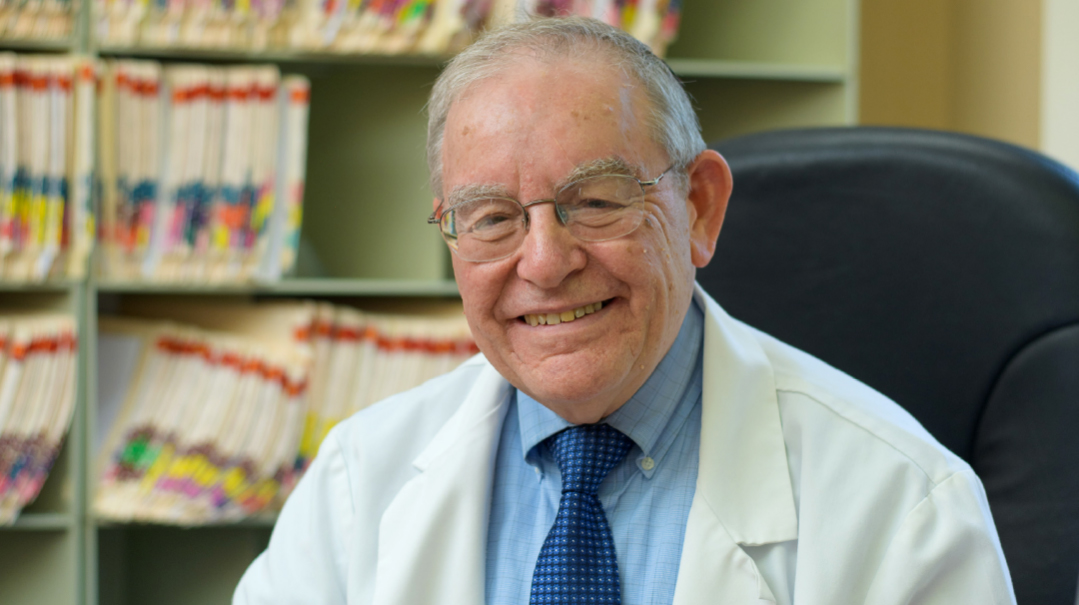It’s in the Bones

New Jersey’s beloved devar torah doctor Raphael Levine shares the gift of healing

Photos: Naftoli Goldgrab
For renowned orthopedic surgeon Dr. Raphael Levine, his work is more than just connecting bones.
It’s about connecting with people. Dr. Levine is not only a highly skilled medical professional who has cared for many rabbanim and chassidic rebbes over the decades. He is also charming, warm, approachable, and sees himself as a partner with Hashem in healing the people who come across his threshold.
While many of his contemporaries have long retired, the joy and dedication that Dr. Levine finds in his work, his patients, and in the deep relationships that he has built, are still keeping him and his long-standing practice in Westwood, New Jersey, busy and dynamic.
Dr. Levine attributes his wide-ranging, multigenerational patient roster to the basics: “To be a good doctor, you have to be interested in people, ” he says.
Dr. Levine’s focus on the human element, coupled with his broad education and his many years of experience, has developed into a unique approach to treating patients that has earned him their loyalty and trust.
Dr. Levine, who lives with his wife Letha in Englewood, New Jersey, isn’t shy about promoting a Torah agenda either. In fact, many know him as the “devar Torah doctor.” Whenever he meets a new patient or has a visit with an “old friend,” an exam won’t begin without some warm, friendly conversation. For his younger patients, Dr. Levine’s expectations at entry are somewhat more distinctive: If that patient has an appointment on a Monday or Tuesday, he’ll be expected to give a devar Torah from the previous week’s parshah. If he visits on a Thursday or Friday, the devar Torah must come from the upcoming parshah. And if the young patient shows up on Wednesday, he can choose from either parshah.
Once, a young boy came in for treatment with a hip problem that would require several surgeries. He approached Dr. Levine after his second visit and explained that they would be seeing a lot of each other in the future, and he just couldn’t provide so many divrei Torah. Dr. Levine gave it serious consideration and then granted him a dispensation. On subsequent visits, he would either offer a devar Torah or remain quiet, as he chose. But even after his course of treatment was complete, Dr. Levine would yet hear more from him. The boy grew up and went to yeshivah in Israel — and for the next three years, every Thursday, Dr. Levine’s office manager would pick up on a call from Israel and connect Dr. Levine with his former patient who would share a devar Torah on the parshah with him.
Dr. Levine’s longstanding practice of asking for divrei Torah hit a roadblock one day when his daughter’s student visited for an orthopedic issue. His daughter Shoshana Schechter, associate dean of Torah studies at Stern College, was teaching Tanach to high school girls at the time, and her student reported that she had been seen by Dr. Levine. Being well familiar with her father’s unique tradition, she asked, “What devar Torah did you give him?” When the student claimed that she hadn’t been asked for a devar Torah, Shoshana followed up with her father.
“But I never ask the girls, only the boys,” Dr. Levine told his daughter in his defense.
This didn’t sit well with Shoshana, who humorously recalls the exchange. “My father brought all of us up to be educated, professional, and passionate people. How could he exclude asking girls for a Torah thought, especially considering that they know Tanach so well?”
After that, Dr. Levine upped his game — and now female patients are invited to share their thoughts on the parshah, too.
Oops! We could not locate your form.







